Rule the universe as the galactic empire or try to save the dream as a true Red Leader in Star Wars The Deckbuilding game. To be perfectly honest: “I don’t have a bad feeling about this.”
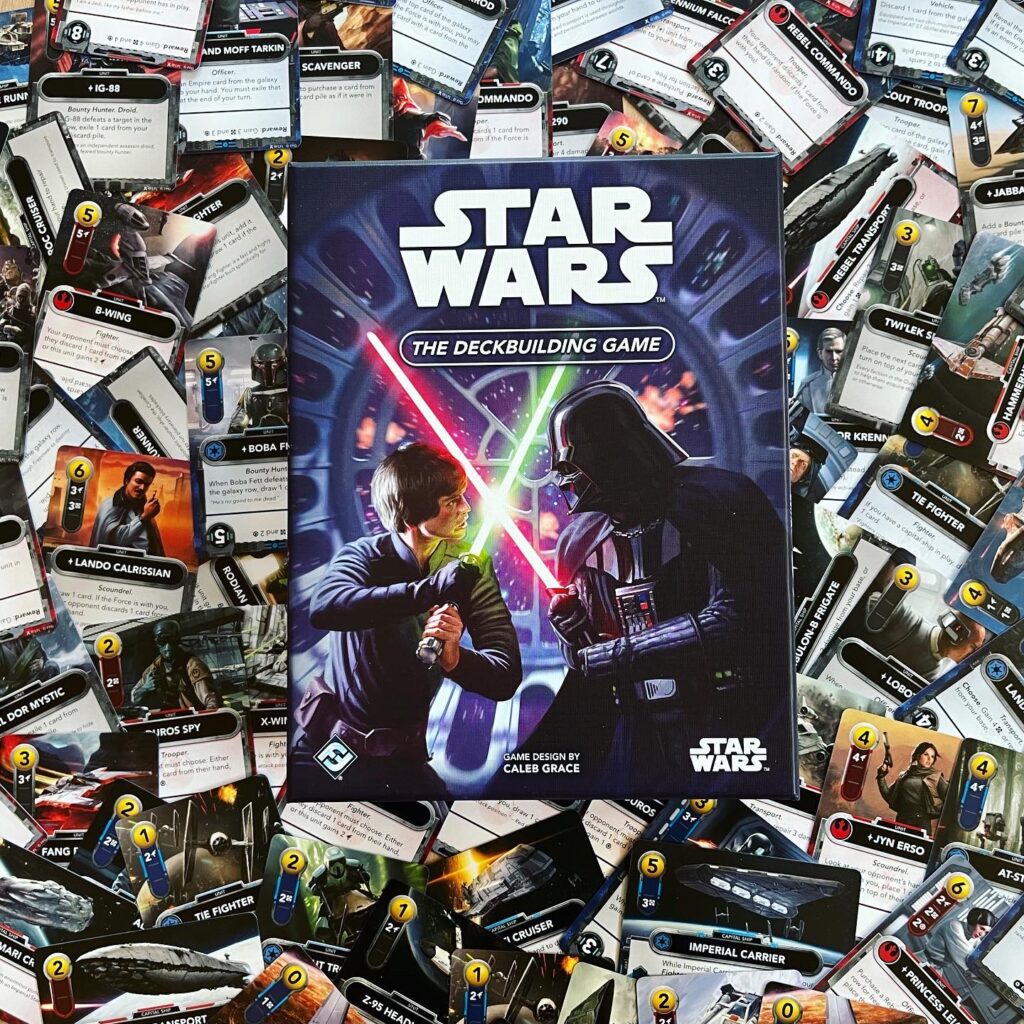
Background
In about two months it will be 4 May aka: May the Fourth. That’s similar to May the Force (be with you) and not entirely coincidentally, that’s why that day was chosen to celebrate Star Wars and its fandom. I am a huge fan of Star Wars. “I am one with the Force and the Force is with me”, you could probably say. Fully in time for May the Fourth, Asmodee is releasing a Star Wars card game through its Fantasy Flight Games label. Not just any card game, but a real deckbuilder.
“A long time ago in a galaxy far, far away….” a game called Dominion was published. Almost immediately upon release, this game was considered as a classic, as Dominion was, in fact, literally and also figuratively a ‘game changer’ and introduced the duickbuilder mechanism to the world. In Dominion, stacks of a lot of different cards are placed on the table and each player also gets a personal deck of (starting) cards. By playing cards, players could buy cards to make their deck better and perform actions to buy even better and more expensive cards in order to be the fastest to collect victory points.
By now, deckbuilders are a genre all on their own and, while still very popular, plenty of players have found refuge elsewhere than Dominion. I like Dominion and consider it to be a good game, but there are deckbuilders that appeal to me more than Dominion does. These deckbuilders are more complex, at the same time play faster and are more interactive.
Star Wars The Deckbuilding Game actually contains all the elements you would expect from a deckbuilder and therefore doesn’t reinvent the genre , but the game contains more than enough twists and a lot of interaction. In addition, the game has a fun and popular theme to appeal to more than enough fans in this universe.
Setup and goal
At the beginning of the game, players choose who will wear the mantle of the Empire and which player will become the rebel red leader. Both players receive a personal deck of bases/planets and also a stack of starting cards to form their first deck with. With the remaining cards, first a pile of Outer Rim pilots is made that both players can hire and with the all remaining remaining cards a large draw pile is made and six cards are placed face-up between players to form a market of cards. In addition to this market, players also place a force tracker to indicate where the force is strongest during the game. Players keep track of this with a cube on this card. At the beginning of the game, the force is stronger with the rebels. “May the force be with you.”
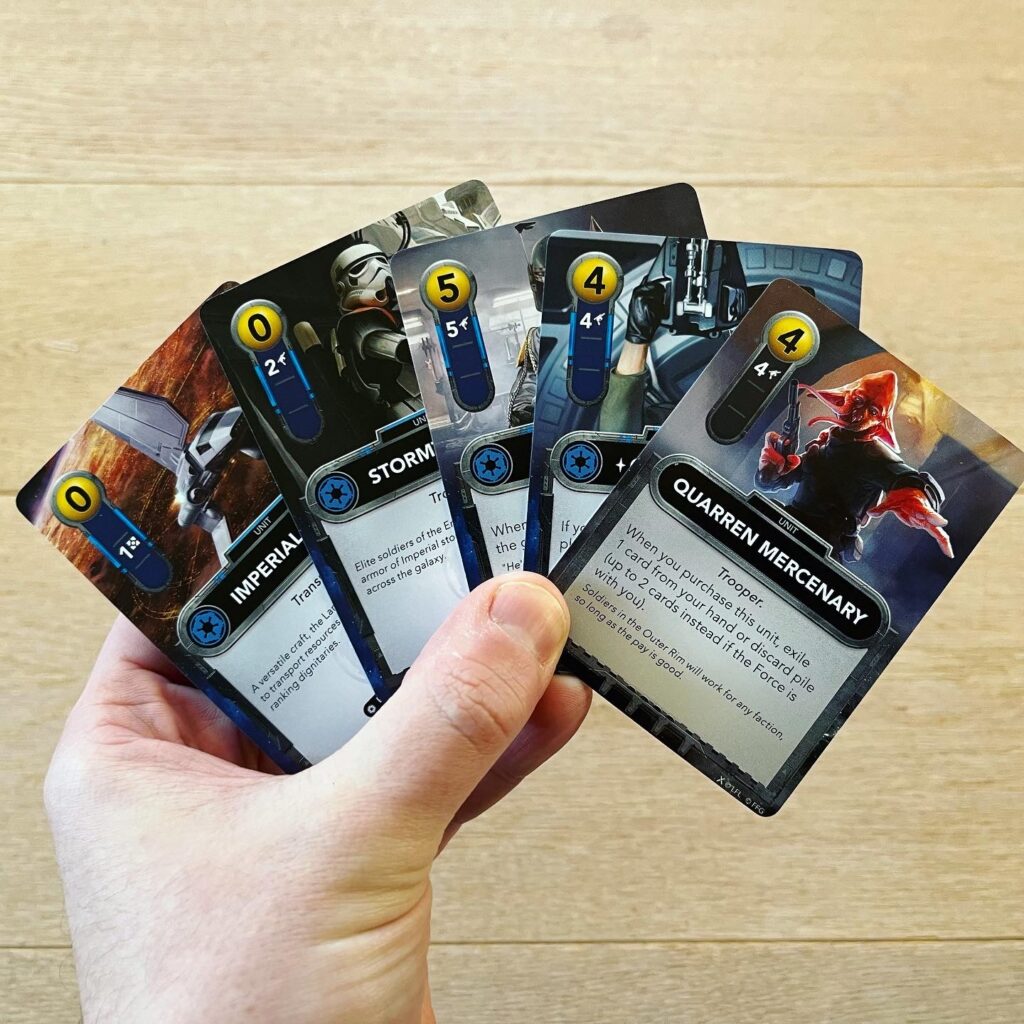
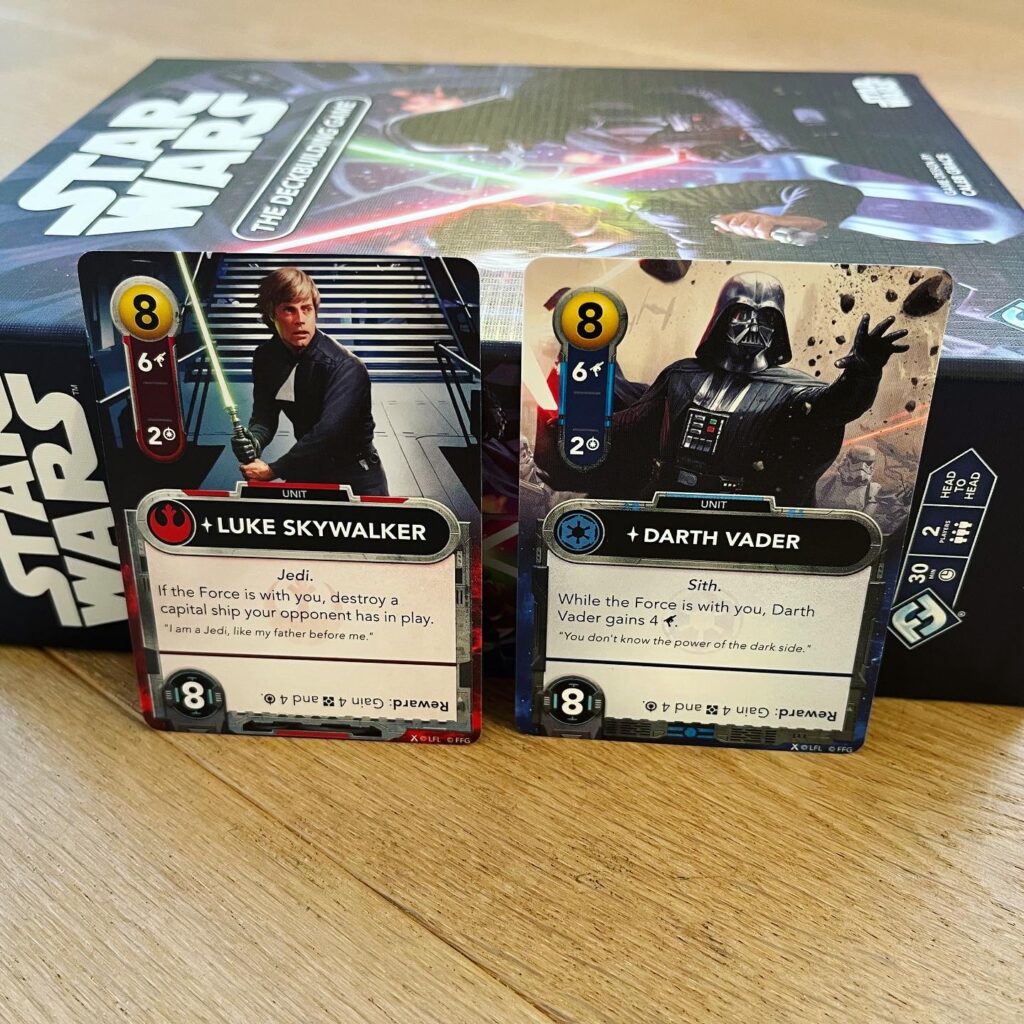
A unique element to this game are the cards with different loyalties. There are empire cards, rebel cards and neutral cards. Although the cards are placed in a central market, they are oriented towards the relevant player. Only the empire player can buy an empire card during the game, but the rebel player can perform actions with (or rather against) these cards, but more on that later. Neutral cards (such as Outer Rim pilots) are turned sideways and can be purchased by either player. These ‘neutral’ scalpers, smugglers and mercenaries are “a wretched hive of scum and villainy” who are only too happy to operate at your side for the right amount of galactic credits.
From the base cards deck, players take their starting planet/base and place this card in front of them on the table. The aim of the game is to destroy enough of the other player’s bases. They do this by acquiring cards, attacking and cleverly assembling and managing their deck. “In my experience, there’s no such thing as luck.” Players draw five cards from their deck and are ready to play.
Gameplay
It is the galactic empire’s first turn, and then each turn is played in turn. If players have no base left at the beginning of their turn, they choose a new one from their pile and place it in front of them. Choosing which base a player has in front of them is an important decision. Some bases have more life points and some have special or strong properties. Players should therefore also choose cards that mix well with their strategy. If players have a so-called flagship, they may get ‘resources’ (the means of payment) for it.
During a turn, players can, in any order and as often as they want/can: play cards, buy cards, use effects of cards, prepare and/or attack.
Playing cards may give players resources or shift the cube on the force track. Resources are indicated by yellow cubes that players can use during their turn to buy cards in their colour (loyalty) or neutral cards from the market. Cards that players purchase are placed on their personal discard pile and can be (re)used by players later in the game when they need to shuffle their discard pile. By buying cards, players try to make their deck stronger and also more efficient to get closer to victory. “This is the way.”
Some cards have special properties that players can use during their turn. When they have played and used a card, they tilt the card to indicate that the effect has been used. Some effects can only be deployed or are stronger if the force is with you and not your opponent. By buying cards smartly and combining special abilities, you can achieve a lot with a small deck. “Make ten men feel like a hundred.”
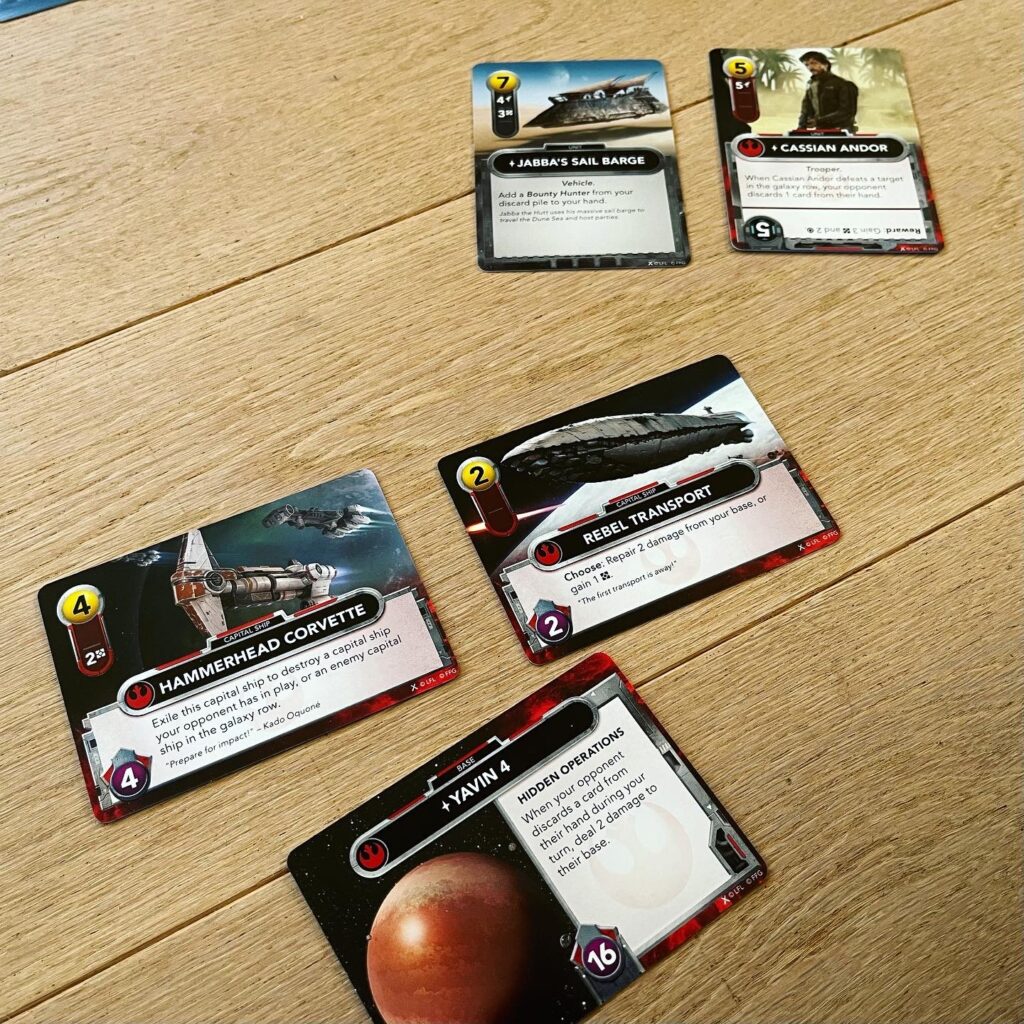

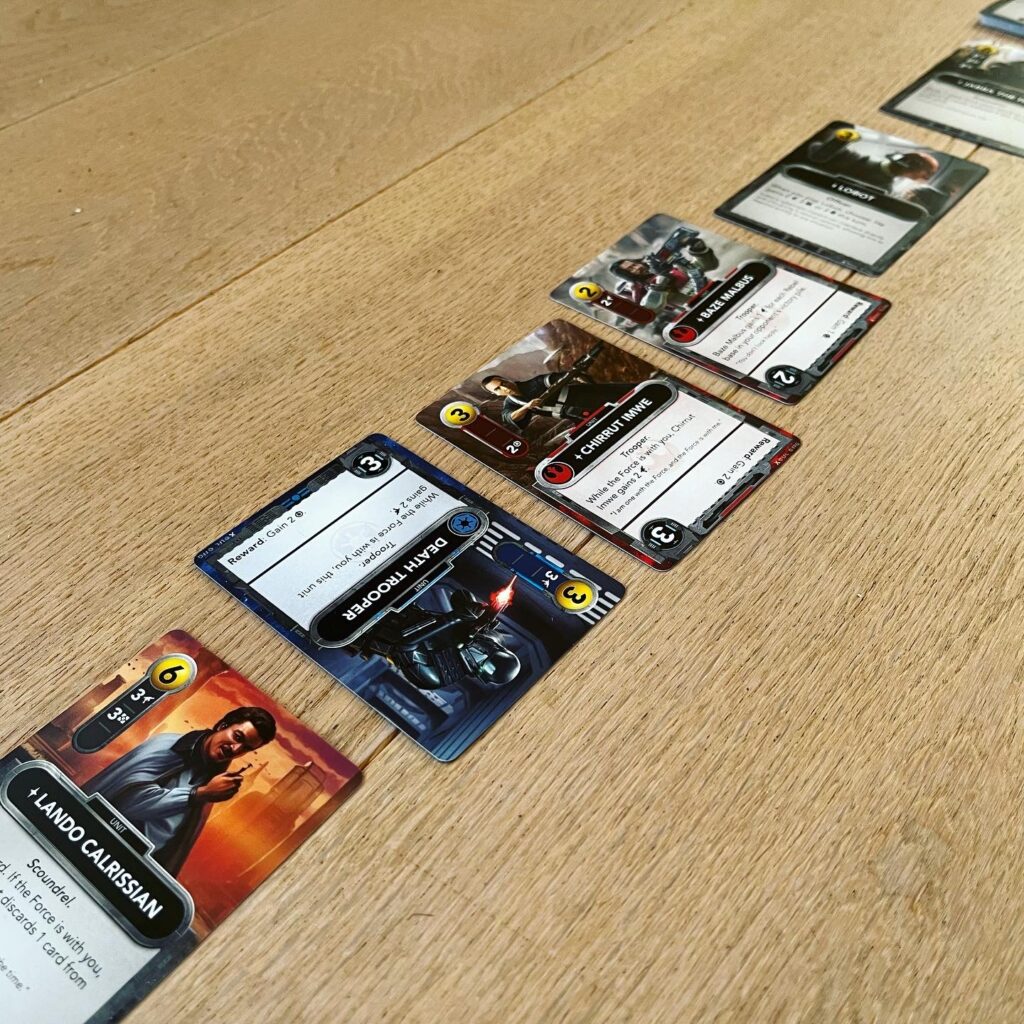
Players can also use played cards with an attack value to attack. They indicate which cards they want to use for an attack and can then attack at the moment during their turn when it suits the player best. There are two possible attacks. Players can attack another player’s base or cards in the market. The market often contains cards in your opponent’s colour. A hugely fun and original element of Star Wars the Deckbuilder is the ability to eliminate these cards. By placing cards with an attack value equal or higher than the selected card in the market, they can discard them to a central discard pile. By destroying these cards, you receive a reward, but even more interesting: this card is now no longer available for your opponent to buy. In my opinion, this element is very original and creates a lot of interaction and dynamics. As a result, players have a great influence on what cards their opponent can acquire.
By the way, a base can only be attacked once all flagships have been destroyed. These are cards that players can buy and play, but which, until destroyed, remain in front of a player’s current base. If flagships are destroyed, they go to the discard pile of the player who had played them.
At the end of the turn, you discard all used cards (except flagships) and unused cards in your hand and also discard all unused resources.
Verdict
Star Wars the Deckbuilding Game is a real surprise to me. The deckbuilding element is pretty straightforward, but the interaction with the market as I described above is an innovative and refreshing element that I can really appreciate. Many well-known Star Wars characters from the time of the Galactic Empire such as, among others, Luke Skywalker, Cassian Andor, Jyn Erso, Boba Fett, Han Solo, Princess Leia and Bossk can be seen in this game, and many of the cards are also very thematically inserted in terms of gameplay. For example, you can sacrifice the Hammerhead Corvette to destroy your opponent’s flagship. Star Wars the Deckbuilding Game is therefore a simple deckbuilder with a fun twist that fans of Star Wars and deckbuilding should not ignore. “A thousand generations live in you now. But this is your fight.”




